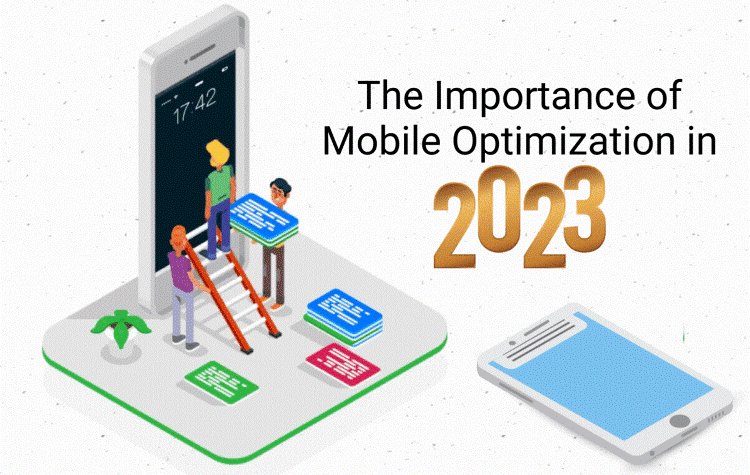Boost User Experience with Cutting-Edge Mobile Optimization
Boost User Experience with Cutting-Edge Mobile Optimization
Blog Article

The Ultimate Overview to Mobile Optimization: Approaches for Enhancing Internet Site Performance on Smartphones and Tablets
The approaches for improving internet site performance on mobile platforms go beyond simple adaptation; they include a detailed strategy that includes responsive layout, speed optimization, content techniques, and user experience improvements. By delving right into the details of mobile optimization, businesses can not only fulfill user expectations but also remain in advance in a competitive digital landscape.
Relevance of Mobile Optimization
Mobile optimization plays an essential duty in boosting customer experience and driving conversion rates in the ever-evolving electronic landscape. With the raising usage of smartphones and tablets for browsing the internet, guaranteeing that sites are optimized for mobile phones has actually come to be essential for services - Mobile Optimization. A mobile-optimized web site not only adapts effortlessly to various display dimensions yet likewise lots swiftly, providing users with a smooth and enjoyable browsing experience
In today's busy world, users expect instant access to information on the move. A website that is not maximized for mobile devices dangers losing prospective clients due to reduce filling times or an inadequate interface. By spending in mobile optimization, organizations can cater to the requirements of their mobile target market, resulting in greater involvement and boosted conversions.
Moreover, search engines like Google prioritize mobile-friendly web sites in their rankings, making mobile optimization essential for enhancing exposure and attracting natural traffic. Mobile Optimization. Generally, the relevance of mobile optimization can not be overemphasized, as it directly affects individual complete satisfaction, conversion rates, and total business success in the electronic world
Responsive Style Methods
Executing receptive layout techniques makes certain that sites dynamically change their format and material based upon the customer's tool display dimension, providing a consistent customer experience across various systems. Among the most common techniques used in responsive style is creating fluid grids that permit content to resize proportionally to the display dimension. This ensures that aspects on the page maintain their relative spacing and plan, maximizing the checking out experience for customers on different tools.
Additionally, using adaptable images that can scale with the dimension of the viewport helps prevent images from being chopped or distorted on smaller sized displays. CSS media inquiries play a crucial role in responsive style by enabling developers to apply certain designs based upon the tool features such as display width, height, and positioning. By leveraging media inquiries, websites can adjust their format and style to match mobile phones, tablet computers, and desktop computer displays seamlessly.
Integrating responsive style methods not only enhances user experience yet likewise adds to boosted search engine positions, as online search engine like Google prioritize mobile-friendly websites in their mobile search engine result. By embracing receptive design, sites can provide to the diverse requirements of users accessing material on a selection of gadgets, inevitably driving engagement and conversions.
Speed and Efficiency Optimization

One trick check my blog technique is enhancing images and multimedia material to minimize file dimensions without compromising high quality. Pressing pictures, leveraging modern-day picture layouts like WebP, and careless filling offscreen photos are effective methods to speed up load times (Mobile Optimization). Lessening HTTP requests, leveraging browser caching, and reducing server reaction times are crucial actions in boosting performance.
Carrying out a material distribution network (CDN) can additionally significantly improve website speed by dispersing material across multiple web servers internationally, reducing latency for users accessing the site from various areas. Focusing on vital above-the-fold material and postponing non-essential manuscripts can even more improve perceived performance. By focusing on speed and efficiency optimization, websites can provide a seamless and gratifying user experience on mobile devices.
Mobile-Friendly Content Techniques
To maximize web content for smart phones, it is important to focus on readability and interaction via critical formatting and succinct messaging. Mobile-friendly web content approaches involve tailoring the her response discussion of details to match the smaller screens and on-the-go nature of smartphone and tablet individuals. One key element is to guarantee that message is quickly readable without the need for zooming in, utilizing font dimensions that are clear on mobile screens. In addition, separating web content into shorter paragraphs and using bullet factors can assist improve readability and make it much easier for individuals to eat info rapidly.
Integrating appealing visuals, such as images and videos maximized for mobile watching, can likewise boost the general customer experience. These visuals should matter, top quality, and lots rapidly to stop users from wearying. Furthermore, incorporating interactive elements like tests, surveys, or studies can increase user involvement and motivate energetic engagement.
Customer Experience Enhancements
Structure on the foundation of mobile-friendly web content approaches, enhancing user experience involves enhancing every touchpoint to ensure seamless interaction and fulfillment for mobile users. One vital facet of improving user experience on mobile devices is making certain quickly loading times. Customers anticipate internet sites to pack quickly on their smartphones and tablet computers, and any delays can result in disappointment and raised bounce rates. Implementing receptive style is another crucial consider boosting user experience. Receptive layout guarantees that internet sites adapt to have a peek here numerous display dimensions and resolutions, offering a regular and straightforward experience throughout various gadgets.
Optimizing types for mobile customers by minimizing the number of fields and using auto-fill attributes can additionally improve the total individual experience. By concentrating on these customer experience enhancements, web sites can efficiently involve and retain mobile visitors.
Final Thought
To conclude, mobile optimization is critical for improving web site performance on smart devices and tablet computers. By implementing receptive style strategies, maximizing speed and performance, developing mobile-friendly web content, and boosting customer experience, organizations can effectively reach and engage with their mobile target market. It is vital for web sites to adjust to the increasing mobile usage patterns in order to stay affordable in the digital landscape.
Report this page